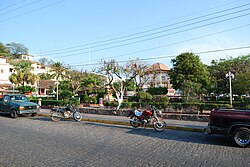This article's factual accuracy may be compromised due to out-of-date information. The reason given is: the majority of this article's sources are from the 2000s and early 2010s. Has anything changed regarding the city's economy and society since?. (December 2023) |
Tehuantepec
Guisi'si Gui | |
|---|---|
City & Municipality | |
| Santo Domingo Tehuantepec | |
 View of the main square of the city | |
| Coordinates: 16°19′28″N 95°14′20″W / 16.32444°N 95.23889°W | |
| Country | |
| State | Oaxaca |
| Founded | 15th century |
| Government | |
| • Municipal President | José Luis Villalobos |
| Area | |
• Municipality | 965.8 km2 (372.9 sq mi) |
| • seat | 16.6 km2 (6.4 sq mi) |
| Elevation | 55 m (180 ft) |
| Population (2020 census)[1] | |
• Municipality | 67,739 |
| • Density | 70/km2 (180/sq mi) |
| • Seat | 45,134 |
| • Seat density | 2,700/km2 (7,000/sq mi) |
| Time zone | UTC-6 (Central (US Central)) |
| • Summer (DST) | UTC-5 (Central) |
| Postal code (of seat) | 70760 |
Tehuantepec (Spanish pronunciation: [tewanteˈpek], in full, Santo Domingo Tehuantepec) is a city and municipality in the southeast of the Mexican state of Oaxaca. It is part of the Tehuantepec District in the west of the Istmo Region. The area was important in pre-Hispanic period as part of a trade route that connected Central America with what is now the center of Mexico. Later it became a secondary capital of the Zapotec dominion, before it was conquered by the Spanish in the early 16th century.
The city is still the center of Zapotec culture in the Isthmus of Tehuantepec and is the second largest in the region. The city is known for its women and their traditional dress, which was adopted by Frida Kahlo. Tehuantepec has a reputation for being a matriarchal society. Women dominate the local markets and are known to taunt men. However, political power is still the domain of men.
The city experienced a short economic boom in the early 20th century related to a rail line that was built linking the two oceans, but it was soon eclipsed by the Panama Canal. The project, however, has revived since 2018, as the Mexican government has worked on the rehabilitation of the line and other projects related to it, in a project known as the Interoceanic Corridor of the Isthmus of Tehuantepec.
- ^ Citypopulation.de Population of Tehuantepec municipality with localities

